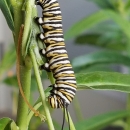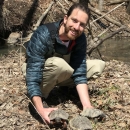Native plants for residential landscaping
At the Alabama Field Office, we spend most of our days conducting surveys, completing consultations and evaluating the best available science to help recover imperiled species. Our heavy workload leaves us with little downtime. But occasionally, we take on side projects. As natural lovers of the great outdoors, it's no surprise that many of us enjoy gardening. So In 2016, we decided to build a native garden at our office.
The journey was off to a rough start; although we succeeded in finding native plants and attracting beautiful pollinators, the garden became a bit overgrown. When our office shut down during the Covid-19 pandemic, our building manager mowed down what looked to be a mini-jungle!
Now, we are back in the office, and more determined than ever to rebuild our native garden. We hope to help other garden enthusiasts learn how to utilize native plants in residential landscaping.
History
In 2016, staff biologist Bill Lynn thought it may be beneficial to replace the office landscaping with a pollinator garden. He was inspired after learning of the loss of habitat for the Monarch Butterfly. With the blessing of the field supervisor and building landlord, our office garden was born!
We planned to build our future garden directly in front of the office's second building. The area on the left side of the front entrance is approximately 20' deep by 35' wide; on the right side of the building, it runs 10' deep by 30' wide. Bill started by tilling both sections and spreading bags of wildflower seeds.
The wildflowers grew and in the coming years Bill and biologist Evan Collins added native perennials to the mix. In 2020, Covid-19 hit the world. Sadly, we had to work from home to help stop the spread. With no staff at the office for nearly two years, it became impossible to maintain the garden, which became extremely wild and over run with weeds. The building owner mowed and sprayed the plants numerous times throughout 2020 and 2021 while we all worked from home.
Starting New
Near the end of 2021, staff started to trickle back into the office. The mowed and weedy garden was an eyesore, and we knew we had to start from scratch. We were able to come up with a plan to make the garden look like less of a bed of weeds and something more appealing to a homeowner. The building owner was also revamping the landscaping on his surrounding buildings, and we wanted a design that would be acceptable to him as well.
We were able to salvage a few different plants that survived the purge, and dug them out or flagged them if there were unable to be removed. We tilled the entire area and put down landscape fabric and mulch.
The goal over the next year is to acquire plants by either growing them from seed or transplanting some from our homes. Unfortunately, we missed the spring planting season. The hot and sometimes dry parts of summer in the south has been a challenge. Once established, these native plants will do much better than non- natives in this unpredictable weather.
Join us on this venture as our garden changes and grows. For regular updates, follow our blog: Pollinator gardens attract amazing wildlife, helps ecosystem
View the list of plants we currently have in the garden, along with links to information on those plants: Plant List







